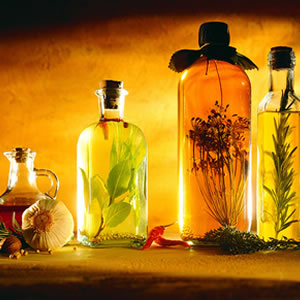Not only are fresh herb vinegars works of art, they can be used in cooking, by using the same proportions as you would wine, fruit and citrus juices, or plain vinegar. Try adding to barbecue sauces or your home-made mustard recipe for a zing of flavor. One of the best ways I can think of to use these delectible vinegars is in making a fresh herb vinaigrette dressing. Simply combine one part infused vinegar to two or three parts olive oil, then add in freshly ground pepper and sea salt to taste. This fresh herb vinaigrette is delicious on salads, of course, and also for dipping warm french bread in. Read on for all you need to know in creating this flavor intensive vinegar that could easily become a main ingredient in your kitchen!
The Do’s and Don’ts of Herb Vinegar Preparation
It is important to begin by using a good quality vinegar. The acidity level should be at least 5%, and steer clear of distilled “flavored” vinegars. The following work beautifully:
-
White wine vinegar
- Red wine vinegar
- Rice wine vinegar
-
Apple cider vinegar
Proper Tools:
-
Bamboo skewers
- Plastic Funnel
- Plastic measuring spoons
- Cork stoppers
NEVER:
-
use metal stoppers, utensils, or bowls of any kind!
- use ground herbs or spices, this will cloud the vinegar.
- store vinegar in direct sunlight (i.e. a windowsill) as this will also cloud the vinegar over time.
Note: There is no need to heat the vinegar before bottling. This tends to weaken its acidity, wilt the fresh herbs, and will make vinegar more prone to cloudiness.
Decorative glass bottles of various shapes and sizes make the perfect home for your fresh herb vinegars. Make sure bottles are sanitized before use.
Herbs and Spices:
-
Fresh herbs should be gently rinsed and patted dry (a paper towel works best), as well as any fruits or berries desired for use.
- Garlic should be peeled, rinsed, and patted dry before being carefully pushed onto skewers. Be careful, skewer ends are quite sharp!
- Red or white onions can be peeled and and added in the form of rings. Smaller amounts are best, as not to overpower. Whole shallots, peeled, rinsed, and patted dry are excellent additions. Try alternating shallots with garlic cloves on skewers.
- Green onions should be washed and patted dry before trimming stems to fit bottle length. Root ends can be left on to add a nice, earthy touch.
- Peppers should have tops and seeds removed, and be washed then patted dry. Make sure to cut peppers into strips that will fit through the bottle mouth. Gloves are highly recommended when handling hot peppers!
- Juniper berries, bay leaves, allspice, ginger root, cloves, coriander seed, cinnamon sticks, cumin seed, and peppercorns are great spices to add to your bottle. All of the spices should remain whole, and if mustard seed is desired for use, be sure to test it in a small amount of vinegar first, to prevent cloudy vinegar.
 Here are a few wonderful ingredient combination ideas to get you started:
-
Parsley, sage, rosemary, and thyme
- Tarragon, shallots, and garlic
- Basil, garlic, and red peppers
- Mint, lemon thyme, and ginger
- Cranberries, mint, and allspice
- Opal basil and white wine vinegar will give your mixture a pink hue.
- Pineapple sage blossoms with white wine vinegar will turn reddish in color.
Herb and spice mixtures are limited merely by the imagination. Have fun creating your own unique flavors!
The Infusion Process:
-
Add desired spices to bottle.
- Insert garlic skewer (or garlic cloves can be dropped directly into the bottle, if preferred).
- Add sprigs of fresh herbs, in an artistic fashion. A bamboo skewer makes a great tool for arranging herbs.
- Now, your work of art is ready for the finishing touch: pour vinegar into bottle, filling bottle 1/2 inch from the top. Push stopper in half way.
- Allow to set for 24 hours, then top off the vinegar, as herbs and spices will soak up some vinegar overnight.
Your masterpiece is now ready to be utilized in your kitchen! The flavor will intesify with time, and refilling vinegar promptly after each use will extend the life of your mixture. Most will last as long as 6 to 8 months, just be sure that all plant material stays completely emerged in vinegar. Enjoy your fresh herb infused vingar, a beautiful addition to your kitchen! These also make wonderful gifts, if there are any special occasions approaching on your calendar.


